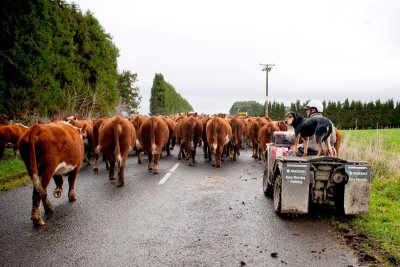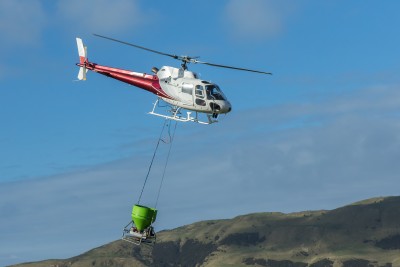 TB slaughter levy changes effective as of 1 October 2024
TB slaughter levy changes effective as of 1 October 2024
An annual review of TB differential slaughter levy rates for beef and dairy cattle has delivered levy updates as part of this year’s TBfree programme.
Each year, the TB differential slaughter levy rates for beef and dairy cattle are reviewed under the TBfree Funders’ Agreement to ensure that the overall funding of the TBfree programme aligns with the agreed funding levels.
This process is an agreement between DairyNZ, Beef + Lamb New Zealand and Deer Industry New Zealand on how they will pay their respective shares in TB eradication. Levies are adjusted to reflect the latest industry Farm Gate Values and slaughter volumes for dairy and beef stock.
From 1 October 2024, the new TB differential slaughter levy rates are:
- $12.25 per head for dairy animals, changing from $11.50 per head
- $4.50 per head for beef animals, changing from $4.75 per head.
Adjustments in differential levy rates don’t provide an overall increase in the annual funding of the TBfree programme — but do ensure consistent funding to enable the programme to deliver.
Beef and dairy farmers should keep their NAIT accounts up to date and record the correct animal type to ensure they are paying the correct TB slaughter levy. For more information and a step-by-step guide on how to change animal production types, see the links below.
 Livestock TB testing - the next 6 months
Livestock TB testing - the next 6 months
You may have heard that AsureQuality has decided to not renew their contract for on-farm TB testing services. OSPRI would like to assure farmers that livestock TB testing will continue and remains an indispensable part of the TBfree programme.
On-farm testing will continue to provide information about the TB status of New Zealand herds, however there will be a reduction in some lower risk areas over the next 6 months.
Whether or not you experience a change in livestock TB testing depends on how we currently control disease in your area. The following map will show you what to expect over the coming months.

Working together
When there’s a hold up on farm, the flow on effect can impact everyone’s day. To ensure testing is done as quickly as possible, here’s a checklist to consider before the tester arrives:
✓ My animals have been mustered and are ready 30min beforehand
✓ My yard is free of any hazards
✓ I have identified risks testers need to be aware of
To ensure we get the most out of the service, we may need your help. Where we think you can assist the cause, we’ll reach out to you - an example might be looking to schedule your testing in coordination with nearby farms.
For more information, please see the link below.
 M. bovis: What causes increased BTM detects in Spring?
M. bovis: What causes increased BTM detects in Spring?
Spring 2024 screening will be a key indicator of success for the M. bovis programme. With no Active Confirmed Properties, we are now looking harder to find any remaining infection, in which Bulk Tank Milk (BTM) screening plays a significant role. The data we collect from surveillance is also crucial towards building confidence that M. bovis is absent in New Zealand’s cattle herd.
However, during Spring we do see a high number of detect results from BTM screening. A detect result is not confirmation of infection, however it does mean further on-farm investigation is required to determine the true infection status of the herd. We appreciate that this can cause disruption at the farm, and we do thank anyone who has been affected for their understanding and support of the M. bovis programme. Fortunately, most on-farm investigation finds no infection following a detect result.
So, what causes this lift in BTM detects? It’s because our screening test has increased sensitivity during early lactation. Although, it should be noted that the start of the milking season is our best time to capture infection risk from milking herds returning from winter grazing and heifers entering the milking platform for the first time, and that most of the Confirmed Properties have been identified during Spring. It’s also the case that farms with a detect result are at a higher risk of being infected than other farms. For these reasons, we follow up with on-farm testing to check the infection status of the farm, and movement control to minimise the risk of possible spread of disease.
Since 2017, 282 farms have been depopulated, and thousands more tested. To date, the response has cost over $700m, including almost $290m paid to farmers to compensate for financial losses incurred because of programme activities. BTM screening plays an important role in protecting this investment. But it’s also important to look for ways to reduce the impact to farmers in the years to come - so we’ll continue to assess how we should respond to detect results, especially if we continue to find no disease.
 Getting behind the Rural Support Trust
Getting behind the Rural Support Trust
OSPRI has committed to annual funding for the Rural Support Trust over the next three years, recognizing their crucial role in helping farmers face economic and personal challenges. The Trust offers one-on-one support to those struggling with rural life pressures, especially during animal disease outbreaks like TB and M. bovis.
Although partially funded by the Ministry for Primary Industries, the Trust relies on additional charitable donations to provide timely assistance. OSPRI’s support is aimed at reinforcing this safety net, reflecting their understanding of the stress animal disease can bring to farming families.
14 Rural Support Trusts operate across regions throughout New Zealand, with a national office providing coordination to ensure ground support remains widely accessible to those who need it.
“I’m hugely proud of each Trusts’ efforts, there’s real comfort in having someone to walk with you during tough times - so providing those rural connections is such an important part of it” says Maria Shanks, General Manager of New Zealand Rural Support Trust. “We’re lucky to have a collection of principal sponsors and partners, and pleased to have OSPRI’s support as they also work amongst our communities”.
 Consultation still open for proposed National Aerial Operations Plan 2025
Consultation still open for proposed National Aerial Operations Plan 2025
We're inviting feedback on the National Aerial Operations Plan 2025, which outlines our proposed TBfree pest control operations for next year.
Possums are the wildlife source of TB infection in cattle and deer in New Zealand. This means key activities for the TBfree programme are:
- possum control
- livestock TB testing
- animal movement control.
We’ve significantly reduced TB infection in cattle and deer herds through careful use of 1080.
We will use your feedback on the nature, boundaries and timing of proposed operations to help inform the final proposal.
Feedback is due by 30 September 2024.
Find out more about the plan, and how to submit feedback on the consultation page below.

